| Canterbury Museum ID |
Title |
Description |
Notes |
filename |
| 2007.160.61 |
Brick, Quinn Frog |
Red brick with rectangular curved shallow frog with indented letters Quinn. Made by William Quinn in Waimate. Evidence on the ends of the top of the circular mould mark. |
William Quinn was a very successful businessman who established Quinns Brick Works at Makikihi - Quinn bricks have been used in many notable buildings in Waimate and Timaru and are know to be of very high quality.Quinns Arcade was built in 1906 by William Quinn designed as an indoor shopping arcade to service the residents of Waimate. Approximately 300,000 bricks of varying designs formed the arcade which ran from High to Grigson Streets with about twelve small shops. Unfortunately the shopping arcade wasn't successful and in 1918 it was remodeled into a movie theatre and billiards hall - the theatre opened on 20 March 1920. The theatre was ornately plastered, with plush red velvet trimmings - seating 175 in the dress circle and 550 in the stalls - the theatre continued to operate successfully until a disastrous fire occurred on June 29, 1955 - since that time the arcade has been used for a range of shops and storage. The Arcade is currently registered with the Historic Places Trust as a category II building. |

2007_160_61.jpg |
| 2007.160.62 |
Brick, plain rectangular frog |
Red brick with shallow rectangular depression frog with curved sides and ends angled down to the central band. |
Frog design along with specific colours of the bricks were used to identify makers and areas in the early years (1840 - 1870) of New Zealand brick making. |

2007_160_62.jpg |
| 2007.160.63 |
Fire brick, angled mark |
Part of a dull deep red fire brick with no frog but four deeply pressed angled marks. Probably came from West Coast from the colour and look and is dated between 1853 and 1872. |
Probably double baked to get depth of colour. Clay colour and type suggest West Coast maker. Firebricks were more likely to have brand marks than frogs as it was important to have a recognizable brand as a guide to the special qualities of the bricks. |
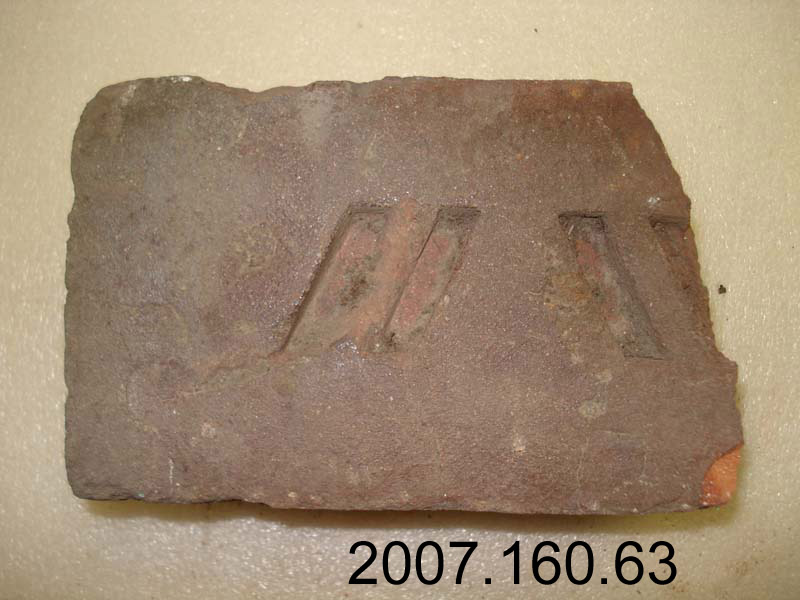
2007_160_63.jpg |
| 2007.160.64 |
Brick, Diamond Frog |
Rectangular red brick with rough bottom. Diamond shaped deep indented frog. Press marks apparent on the corners. Made by Thomas Hills. |
Thomas Hills, brick maker came to Rangiora in 1858 in the Roehampton. His first kiln built in 1862 was on the Fernside Road and had a capacity of around 15,000 bricks a burn. A new enclosed kin was built in 1877 with a 100,000 capacity and yet another continuous burning kiln in 1880 with a 150,000/month output. His second kiln was on the site of Brick Kiln Road. The clay in this area was of a superior quality and the company manufactured the much in demand red bricks and drain-pipes, until the early 1900s. The factory was taken over (after the retirement of Thomas) by the North Canterbury Brick Tile and Pottery Company Ltd. |
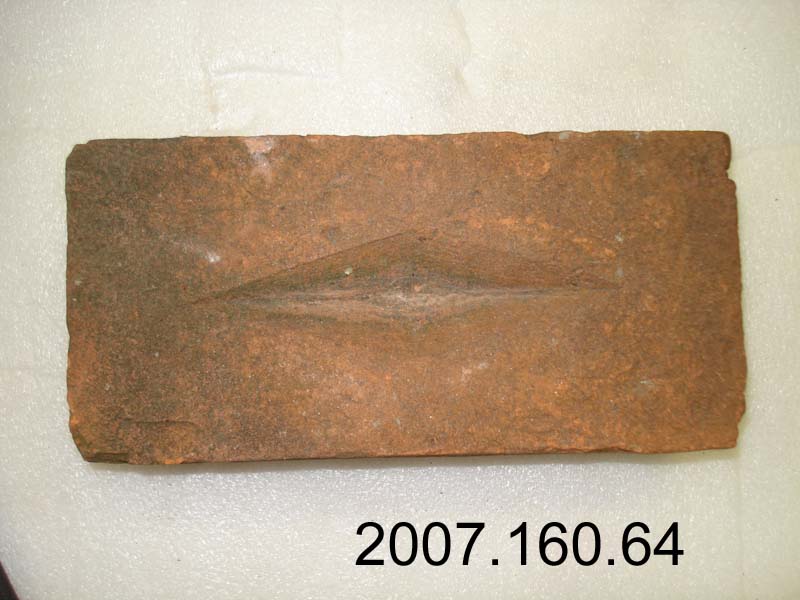
2007_160_64.jpg |
| 2007.160.65 |
Brick used for wells |
Curved red well brick with shallow wedged shaped depression with raised pointed stave shaped frog. |
The pointed stave frog indicates that the brick is most likely to have been made on the West Coast |

2007_160_65.jpg |
| 2007.160.66 |
Brick, Star Frog |
Rectangular red brick with indented five point star frog. Made by John Savage, of the brick and quarry partnership of Prisk and Savage. |
Savage later managed the Glenmore Brick Co (formed in 1901) which took over Prisk and Savage. Prisk, Savage & Co had a business premises on Hills Road, Christchurch. Savage live in Gelmore House (first purchased by Henry Selfe of the Canterbury Association) which was purchased by the Glenmore Brick and Tile Company around 1900. They sold it in 1942. |
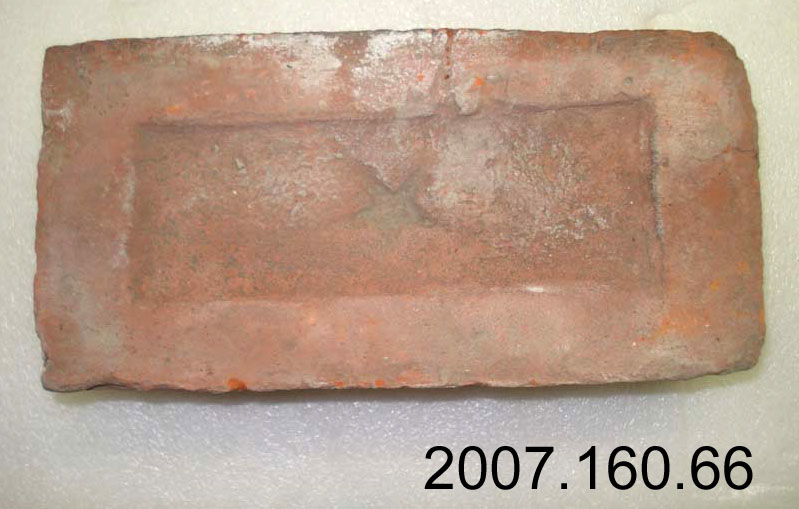
2007_160_66.jpg |
| 2007.160.67 |
Brick with Double Frog |
Rectangular faun brick with rectangular depression frog with angled corners on one side with air bubble hole in centre. On other side is a second frog with curved angled sides, curved cut off corners. Circa 1892 - 1900. |
Most likely made by Crum Brothers of Ashburton who were renowned for their double frogged bricks. This brick has a fancy frog on one side. Albert Crum and his brothers purchased the brickworks in Ashburton off the Friedlander brothers in 1895. In 1902 the introduced steam power to the works. Albert Crum worked as a brickmaker and building contractor, operating from Ashburton. In 1905 Albert sold out to younger brothers Oliver and Frank who entered partnership with Lauritz Dyhrberg and traded as Crum Bros. and Dyhrberg. In the 1920s the plant shifted to electric power. In 1921 Dyhrberg withdrew from partnership. IN 1978 the brickworks closed down and in 1988 the kiln was demolished. Albert moved to Auckland and established the NZ Brick Tile & Pottery Co in Avondale. This was taken over by R O Clark Ltd in 1924, and in 1929, the 4 sons of Albert Crum formed a partnership and founded the Crum Brick Tile & Pottery Co. In Ashburton the bricks were hand made until 1900. Clay was thrown into a wooden mould, cut off level and a hollow called a frog was pressed into the clay to compress it. The brick was then tipped out to dry before firing. Various shapes and sizes of bricks were made as well as ornamental and plain chimney pots and field tiles. Dry bricks were stacked in a circular Hoffman kiln of twelve chambers with each chamber holding 5000 bricks. The output from the kiln was one chamber per day or about enough for five houses per week. Alberts records of the company along with his later companies, including drawings of the brick making and pressing machines used are held in the Auckland War Memorial Museum Library Te Pataka Matapuna Ms 1051. Ashburton Museum has some early records of this company including photographs. |

2007_160_67.jpg |
| 2007.160.68 |
Brick, plain rectangular frog |
Heavy red brick with deep rectangular depression frog with angled sides and central band with indented arrow shape. |
Frog design along with specific colours of the bricks were used to identify makers and areas in the early years (1840 - 1870) of New Zealand brick making. |
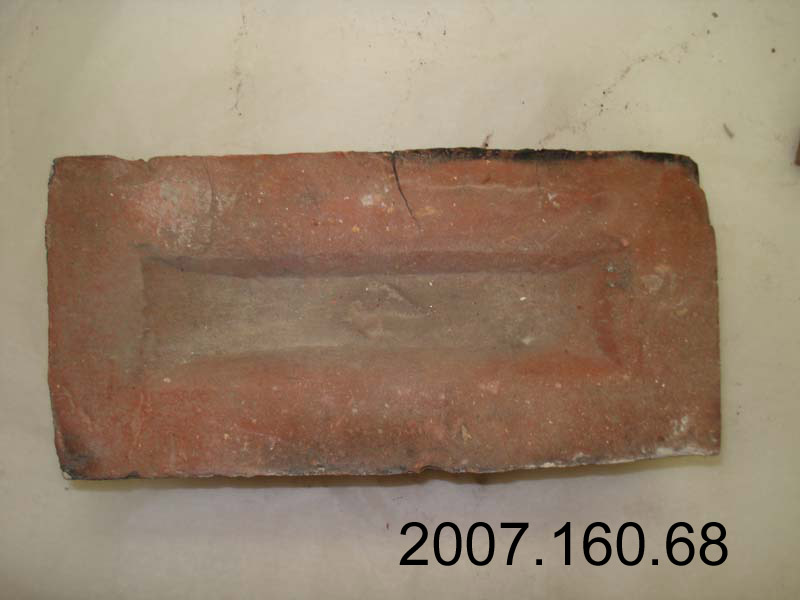
2007_160_68.jpg |
| 2007.160.69 |
Brick, plain rectangular frog |
Pinkish/red brick with deep rectangular depression frog with angled sides and narrow central band. |
Frog design along with specific colours of the bricks were used to identify makers and areas in the early years (1840 - 1870) of New Zealand brick making. |
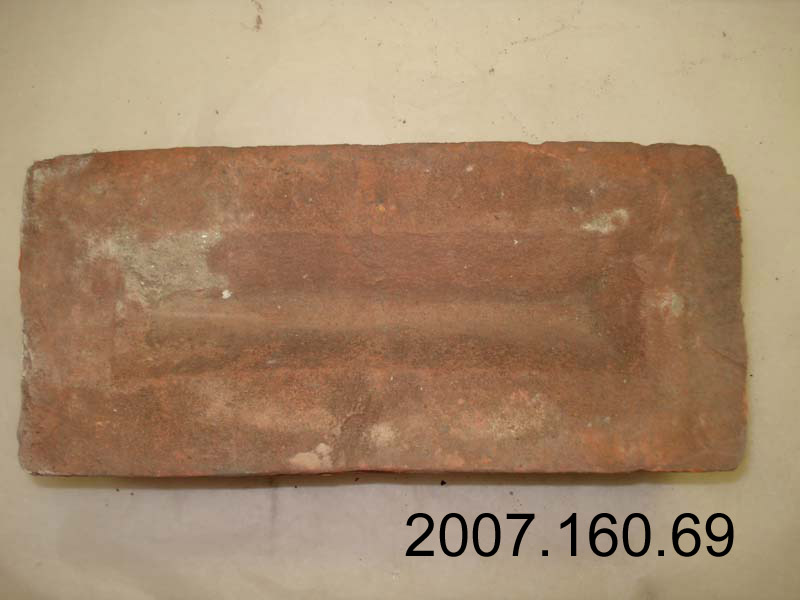
2007_160_69.jpg |
| 2007.160.70 |
Brick, plain rectangular frog |
Orange brick with deep rectangular depression frog with curved sides and bottom. |
Frog design along with specific colours of the bricks were used to identify makers and areas in the early years (1840 - 1870) of New Zealand brick making. |
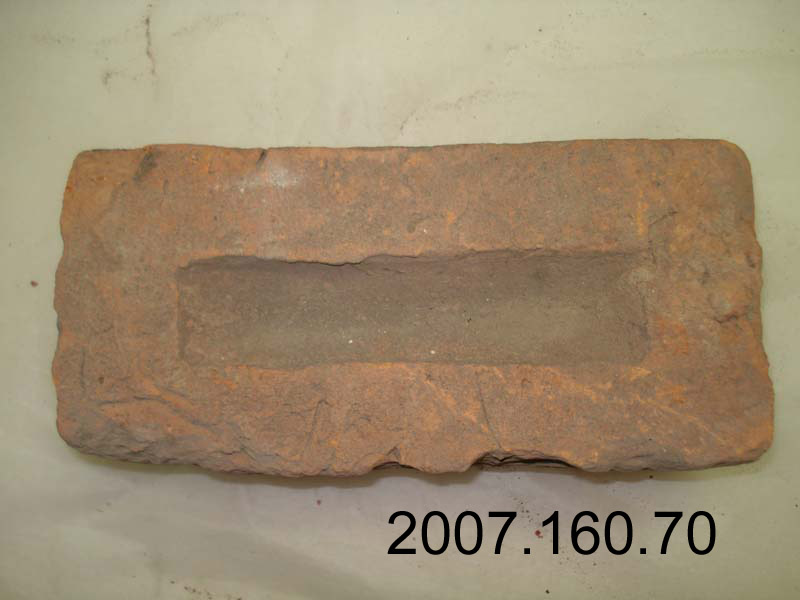
2007_160_70.jpg |

